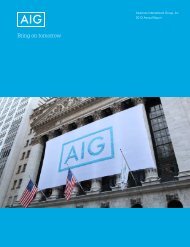2007 Annual Report - AIG.com
2007 Annual Report - AIG.com
2007 Annual Report - AIG.com
You also want an ePaper? Increase the reach of your titles
YUMPU automatically turns print PDFs into web optimized ePapers that Google loves.
American International Group, Inc. and Subsidiaries<br />
For 2008, <strong>AIG</strong> purchased a U.S. catastrophe coverage of<br />
approximately $1.1 billion in excess of a per occurrence deducti-<br />
ble of $1.5 billion. For Life Insurance & Retirement Services,<br />
<strong>AIG</strong>’s 2008 catastrophe program covers losses of $250 million in<br />
excess of $200 million for Japan and Taiwan only.<br />
Reinsurance Recoverable<br />
General reinsurance recoverable assets are <strong>com</strong>prised of:<br />
( balances due from reinsurers for indemnity losses and loss<br />
expenses billed to, but not yet collected from, reinsurers (Paid<br />
Losses Recoverable);<br />
( ultimate ceded reserves for indemnity losses and expenses<br />
includes reserves for claims reported but not yet paid and<br />
estimates for IBNR (collectively, Ceded Loss Reserves); and<br />
( Ceded Reserves for Unearned Premiums.<br />
At December 31, <strong>2007</strong>, general reinsurance assets of<br />
$21.5 billion include Paid Losses Recoverable of $1.8 billion and<br />
Ceded Loss Reserves of $16.2 billion, and $4.0 billion of Ceded<br />
Reserves for Unearned Premiums. The methods used to estimate<br />
IBNR and to establish the resulting ultimate losses involve<br />
projecting the frequency and severity of losses over multiple years<br />
and are continually reviewed and updated by management. Any<br />
adjustments are reflected in in<strong>com</strong>e currently. It is <strong>AIG</strong>’s belief<br />
that the ceded reserves for losses and loss expenses at<br />
December 31, <strong>2007</strong> were representative of the ultimate losses<br />
recoverable. Actual losses may differ from the reserves currently<br />
ceded.<br />
<strong>AIG</strong> manages the credit risk in its reinsurance relationships by<br />
transacting with reinsurers that it considers financially sound, and<br />
when necessary <strong>AIG</strong> requires reinsurers to post substantial<br />
collateral in the form of funds, securities and/or irrevocable<br />
letters of credit. This collateral can be drawn on for amounts that<br />
remain unpaid beyond specified time periods on an individual<br />
reinsurer basis. At December 31, <strong>2007</strong>, approximately 55 percent<br />
of the general reinsurance assets were from unauthorized reinsur-<br />
ers. The terms authorized and unauthorized pertain to regulatory<br />
categories, not creditworthiness. More than 50 percent of these<br />
balances were collateralized, permitting statutory recognition.<br />
Additionally, with the approval of insurance regulators, <strong>AIG</strong> posted<br />
approximately $1.8 billion of letters of credit issued by <strong>com</strong>mer-<br />
cial banks in favor of certain Domestic General Insurance<br />
<strong>com</strong>panies to permit those <strong>com</strong>panies statutory recognition of<br />
balances otherwise uncollateralized at December 31, <strong>2007</strong>. The<br />
remaining 45 percent of the general reinsurance assets were from<br />
authorized reinsurers. At December 31, <strong>2007</strong>, approximately<br />
87 percent of the balances with respect to authorized reinsurers<br />
are from reinsurers rated A (excellent) or better, as rated by A.M.<br />
Best, or A (strong) or better, as rated by S&P. These ratings are<br />
measures of financial strength.<br />
<strong>AIG</strong>’s Reinsurance Security Department (RSD) conducts periodic<br />
detailed assessments of the financial status and condition of<br />
current and potential reinsurers, both foreign and domestic. The<br />
RSD monitors both the nature of the risks ceded to the reinsurers<br />
and the aggregation of total reinsurance recoverables ceded to<br />
reinsurers. Such assessments may include, but are not limited to,<br />
identifying if a reinsurer is appropriately licensed and has<br />
sufficient financial capacity, and evaluating the local economic<br />
environment in which a foreign reinsurer operates.<br />
The RSD reviews the nature of the risks ceded to reinsurers<br />
and the need for credit risk mitigants. For example, in <strong>AIG</strong>’s treaty<br />
reinsurance contracts, <strong>AIG</strong> frequently includes provisions that<br />
require a reinsurer to post collateral when a referenced event<br />
occurs. Furthermore, <strong>AIG</strong> limits its unsecured exposure to reinsur-<br />
ers through the use of credit triggers, which include, but are not<br />
limited to, insurer financial strength rating downgrades, declines in<br />
policyholders surplus below predetermined levels, decreases in<br />
the NAIC risk-based capital (RBC) ratio or reaching maximum limits<br />
of reinsurance recoverables. In addition, <strong>AIG</strong>’s CRC reviews all<br />
reinsurer exposures and credit limits and approves most large<br />
reinsurer credit limits that represent actual or potential credit<br />
concentrations. <strong>AIG</strong> believes that no exposure to a single<br />
reinsurer represents an inappropriate concentration of risk to <strong>AIG</strong>,<br />
nor is <strong>AIG</strong>’s business substantially dependent upon any single<br />
reinsurance contract.<br />
<strong>AIG</strong> enters into inter<strong>com</strong>pany reinsurance transactions for its<br />
General Insurance and Life Insurance & Retirement Services<br />
operations. <strong>AIG</strong> enters into these transactions as a sound and<br />
prudent business practice in order to maintain underwriting<br />
control and spread insurance risk among <strong>AIG</strong>’s various legal<br />
entities and to leverage economies of scale with external<br />
reinsurers. When required for statutory recognition, <strong>AIG</strong> obtains<br />
letters of credit from third-party financial institutions to collateral-<br />
ize these inter<strong>com</strong>pany transactions. At December 31, <strong>2007</strong>,<br />
approximately $8.8 billion of letters of credit were outstanding to<br />
cover inter<strong>com</strong>pany reinsurance transactions between<br />
subsidiaries.<br />
Although reinsurance arrangements do not relieve <strong>AIG</strong> subsidi-<br />
aries from their direct obligations to insureds, an efficient and<br />
effective reinsurance program substantially mitigates <strong>AIG</strong>’s exposure<br />
to potentially significant losses. <strong>AIG</strong> continually evaluates the<br />
reinsurance markets and the relative attractiveness of various<br />
arrangements for coverage, including structures such as catastro-<br />
phe bonds, insurance risk securitizations, ‘‘sidecars’’ and similar<br />
vehicles.<br />
Based on this ongoing evaluation and other factors, effective<br />
December 31, <strong>2007</strong>, Lexington and Concord Re Limited agreed to<br />
<strong>com</strong>mute their quota share reinsurance agreement covering<br />
U.S. <strong>com</strong>mercial property insurance business written by Lexington<br />
on a risk attaching basis. This agreement was effective in July<br />
2006 and was due to expire on January 15, 2008.<br />
<strong>AIG</strong> <strong>2007</strong> Form 10-K 117

















